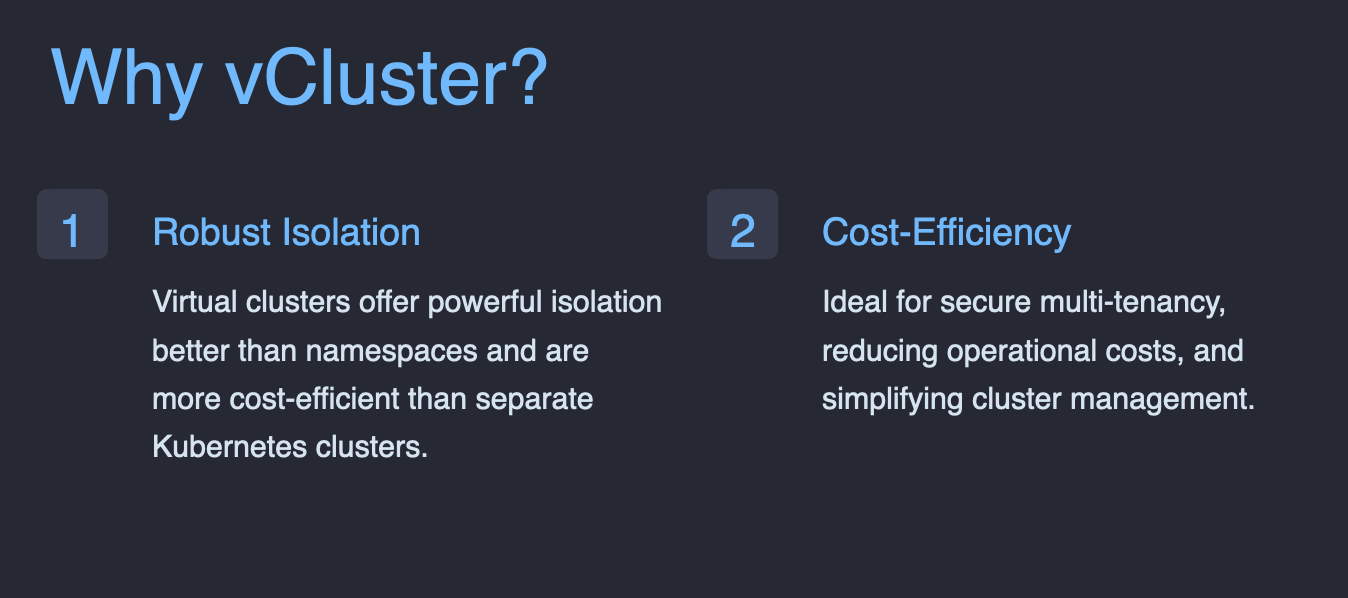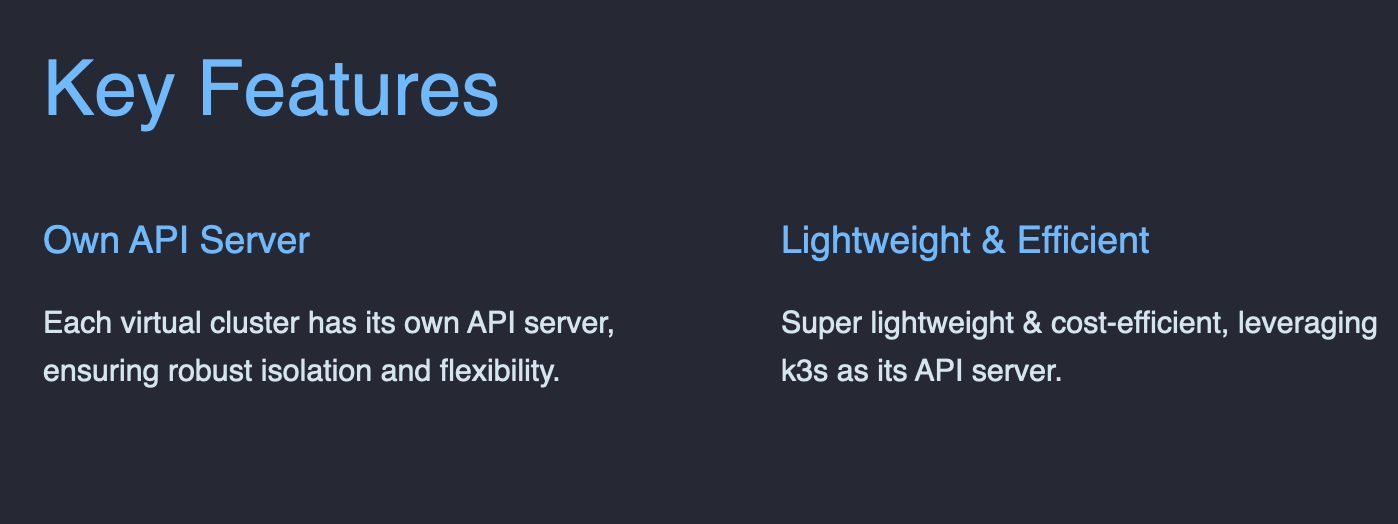vCluster Deep Dive - Powering Kubernetes Environments
Transforming Kubernetes Ecosystems — The Role of vCluster in Enhancing Cluster Efficiency
Introduction
In the vast and ever-evolving landscape of Kubernetes, the introduction of vCluster marks a significant leap forward in how organizations manage their Kubernetes environments. At its core, vCluster — short for virtual cluster — is a magical tool that enables the creation of fully functional Kubernetes clusters within a single physical cluster. This innovative approach not only streamlines cluster management but also optimizes resource utilization, making Kubernetes environments more efficient, scalable, and secure.
The genesis of vCluster can be traced back to the growing need for more agile and resource-efficient ways to manage multiple k8s clusters. Traditional methods often involve juggling numerous physical clusters, each requiring its own set of resources, management tools, and security protocols. This not only compounds operational complexity but also significantly inflates costs. vCluster emerges as a beacon of efficiency in this context, offering a solution that encapsulates the power of Kubernetes while addressing its inherent complexities.
Why vCluster?
The advent of vCluster is a direct response to several pressing challenges faced by organizations in managing Kubernetes environments. As Kubernetes clusters become ubiquitous in powering modern applications, the need for a more streamlined, cost-effective, and secure way to manage these clusters has become paramount. vCluster addresses these needs head-on, providing a multitude of benefits that traditional cluster management solutions fall short of offering.
The Challenges of Managing Multiple Physical Clusters
Managing multiple Kubernetes clusters is akin to juggling a set of complex, interconnected systems, each with its own set of demands. This complexity is not just technical but also operational, involving a delicate balance of resource allocation, security, and compliance. The overhead of maintaining several clusters can quickly become a bottleneck, stifling innovation and agility.
Cost Implications and Resource Inefficiencies
The financial aspect of running multiple physical clusters cannot be overstated. Each cluster requires its own set of resources, from computing power to storage, even if they are underutilized. This leads to significant resource inefficiencies and, by extension, inflated costs. Organizations find themselves paying for resources that are not being fully exploited, an unsustainable model in the long run.
The Need for Isolation and Security in Multi-tenant Environments
In multi-tenant environments, where multiple teams or customers share cluster resources, ensuring isolation and security is paramount. Traditional cluster management solutions often struggle to provide adequate isolation, leading to potential security risks and interference between tenants. vCluster offers a robust solution to this problem, ensuring that each virtual cluster operates in isolation, thereby enhancing security and minimizing the risk of cross-tenant interference.
Stay tuned as we delve deeper into the key features of vCluster, offering insights into its innovative architecture and exploring practical use cases that highlight its transformative impact on Kubernetes environments.
Key Features of vCluster
vCluster stands out in the Kubernetes ecosystem for its innovative approach to cluster management, offering a suite of features designed to address the complexities and inefficiencies associated with traditional Kubernetes deployments. Here’s a closer look at the key features that make vCluster a game-changer for developers, operators, and organizations alike.
Isolation
One of the hallmark features of vCluster is its ability to provide true isolation between virtual clusters. This is achieved by encapsulating each virtual cluster within its own namespace in the host cluster, ensuring that workloads, resources, and network traffic are completely segregated. This level of isolation is crucial in multi-tenant environments, where ensuring the privacy and security of each tenant’s data and applications is paramount.
Resource Efficiency
vCluster optimizes the use of underlying physical resources, allowing multiple virtual clusters to share the same physical infrastructure without compromising performance or security. This results in significant cost savings, as it reduces the need for additional hardware and allows for more efficient use of computing, storage, and network resources. Organizations can dynamically allocate and reallocate resources based on demand, ensuring optimal utilization across all virtual clusters.
Scalability
The virtual nature of vCluster enables unparalleled scalability. Administrators can easily spin up or tear down virtual clusters as needed, without the overhead associated with provisioning new physical infrastructure. This flexibility supports agile development practices and rapid scaling in response to changing workloads, making it easier to manage peak demand periods or experiment with new applications and services.
Compatibility
vCluster is designed to work seamlessly with existing Kubernetes tools and workflows, including Helm charts, kubectl commands, and CI/CD pipelines. This compatibility ensures that developers and operators can continue using the tools and processes they are familiar with, reducing the learning curve and accelerating adoption. vCluster acts as a transparent layer on top of the host cluster, enabling straightforward integration into existing Kubernetes environments.
Simplicity
By abstracting the complexity of managing multiple Kubernetes clusters, vCluster simplifies the operational overhead for teams. It provides a unified interface for deploying, managing, and monitoring virtual clusters, streamlining administrative tasks and reducing the potential for configuration errors. This simplicity extends to security and compliance, as policies can be applied consistently across all virtual clusters, ensuring a uniform security posture.
Installation Guide
Setting up vCluster is a straightforward process that involves a few simple steps. Here’s a quick guide to get you started:
Prerequisites:
A running Kubernetes cluster: vCluster needs an existing Kubernetes cluster to host the virtual clusters.
Helm: Helm is used to deploy the vCluster operator to your Kubernetes cluster.
vCluster CLI: The vCluster command-line tool is used to create and manage virtual clusters.
Install the vCluster CLI:
Download and install the vCluster CLI from the official GitHub repository or via package managers like Homebrew for macOS.
Deploy the vCluster Operator with Helm:
Use Helm to deploy the vCluster operator to your Kubernetes cluster. This operator is responsible for managing the lifecycle of virtual clusters.
Create Your First Virtual Cluster:
With the CLI installed and the operator running, you can now create your first virtual cluster using a simple CLI command. Specify the name and namespace for your virtual cluster, and the CLI will handle the rest.
Access and Manage Your Virtual Cluster:
Once your virtual cluster is up and running, you can access it using kubectl, just like you would with any standard Kubernetes cluster. The vCluster CLI also provides commands for managing the virtual cluster, such as scaling, deleting, and listing virtual clusters.
This installation guide provides a high-level overview of the process. For detailed instructions, including specific commands and configuration options, refer to the official vCluster documentation — Install vCluster CLI | vcluster docs | Virtual Clusters for Kubernetes
Keep reading with a 7-day free trial
Subscribe to Cloud Experts Hub to keep reading this post and get 7 days of free access to the full post archives.




